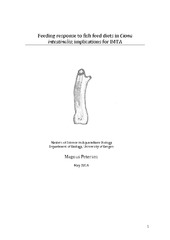| dc.description.abstract | Norway is the largest salmon producer in the world. The associated discharge with continued growth from salmon production has vitalised interest in developing integrated multi trophic aquaculture (IMTA) in order to mitigate environmental effects, while producing additional commercial species. The solitary filter feeding ascidian, Ciona intestinalis ability to ingest and filter fish feed was determined using qPCR and two common filter feeding methods. To establish whether Ciona actually ingested fish feed, a bioassay detecting soy RuBisCO in fish feed, was conducted on extracted DNA from intestines in animals given fish feed, algae and seston. We found that fish feed was removed from the water column. In the group fed algae and fish feed, 10/10 animals ingested fish feed, while the group given solely fish feed, 7/10 animals ingested fish feed, we argue that the difference between the two treatments might be regulated by squirting provoked by large particles in fish feed. The reported filtering capacity of Ciona intestinalis varies considerably in the literature. Therefore we developed our own individual flow through system with special care to avoid methodological constrictions. Furthermore we used two common indirect approaches; the flow through and clearance methods, with individuals and groups of ten animals, respectively. The experimental animals were fed diets with varying concentrations of fish feed and results from the two methods were compared. Our data indicate that animals can clear mixtures of fish feed and seston at a rate of 50-60 mL/min (3-3.6 L/h) per g^-1 dry weight, unless the concentrations are too high (>40.000 particles/mL). Clearance rates did not differ between both methods and were within values from previous studies. The response to elevated particles concentrations is characteristic of a Holling type I functional response. However at intermediate concentrations, clearance rates were initially reduced, but gradually increased over time in individuals, while this was not found when measuring multiple animals, suggesting non-synchronous inter-individual variation in feeding responses. The ability to retain particles differed between the two methods, but differences disappeared when non-feeding individuals were excluded. Our data were within reported values, and animals completely retained particles over 2μm (100%), while clearing particles down to 1.5μm with around 75% efficiency. Lastly our data suggests that Ciona can be used as an efficient bio-filtering organism in salmon driven IMTA, and would likely extract more available particulate discharge than the commonly used Blue Mussel. | en_US |
